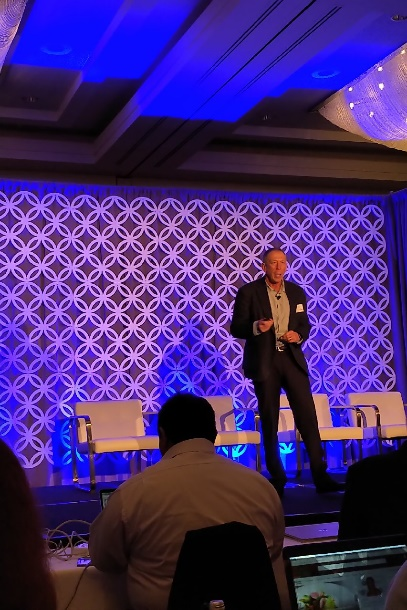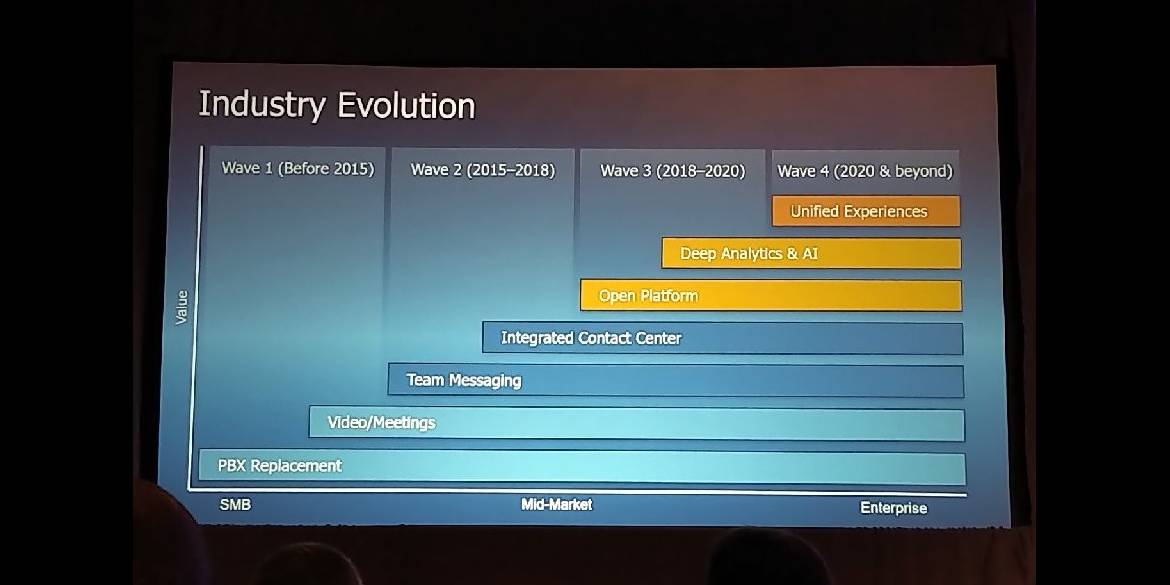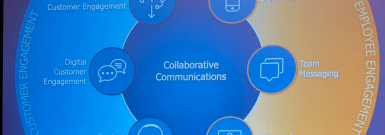

RingCentral Analyst Event – Here’s What Got My Attention
Last week, several BC Experts attended RingCentral’s analyst event, and with so many conferences lately, we’ve been seeing a lot of each other. Since most of these companies are chasing the same end customers with similar offerings, a lot of the messaging has become very familiar. To be fair, that’s largely unavoidable, so it doesn’t take long to tune out what I’ve been hearing at all the other events. Everyone has a cloud story, everyone is doing AI, and everyone is focused on CX. Yadda, yadda, yadda.
What does get my attention is hearing about a clear sense of purpose that addresses an identifiable problem set. At face value, the solution is transactional, but when the impact is transformational, that’s a more interesting story.
There are lots of ways to get that message across, and I thought RingCentral did a good job on that front. Considering the event was just a single day, they packed a lot in, so there’s a lot to digest. Also, quite a bit of the good stuff was under NDA prior to next week’s Enterprise Connect conference, so you’ll have to wait to get the whole story. Until then, here are two strands of messaging that stood out for me from RingCentral.
1. Walk before you run – it’s about PBX replacement
I’ve worked with RingCentral off and on for a few years, but this was the first time the stars lined up for me to attend their analyst event. This was also my first time seeing Vlad Shmunis, their Founder and CEO. His presentation style is understated, but I could really sense his passion for success and vision for helping customers navigate the digital transformation journey.
While it would be easy to talk like an engineer and focus on how all the various technologies enable wonderful possibilities to move that journey along, he was more practical, and for me, more relatable. Every company has to talk about digital transformation, but for him, it’s about employee engagement, not the technology. Focus on the desired behavior, and that will tell you what technologies are required.
We hear about that in the contact center as well – don’t focus just on customer engagement. That’s the objective, but the best way to achieve it is by having engaged agents – give them the tools to do their job, and you’ll get great customer engagement.
Coming back to the business, voice is foundational for employee engagement. Aside from interacting face-to-face, it’s the most important communications mode, and until recent times, this meant the phone system. While many of us don’t think or talk about PBX any more, the installed base remains massive, and will be with us for years to come.
Aside from that basic reality, Vlad rightly noted that it’s easy to overlook voice, especially when cloud is becoming the go-to for everything. Unless properly done, cloud-based options cannot deliver the enterprise-grade quality needed for businesses, and there’s a reason why PBXs remain in use until they die. If voice quality suffers, so will employee engagement, so the connection here isn’t hard to see.
For this reason, PBX replacement is the core of their value proposition. It’s tempting to aim higher and focus on streamlining business processes or integrating channels with UC, but if you can’t deliver enterprise-grade telephony, you’ll never get to those other spaces. At some point, every business will need to replace their phone system, and for RingCentral, that’s the key point of entry. Of course, they’re not just doing this to update the PBX – it’s just as much about eliminating the constraints that come with premises-based, legacy voice technology.
This may sound simplistic, but it’s foundational for everything that drives RingCentral’s success. Keep in mind that the cell phone didn’t replace anything, and nor did the Internet. These were new technologies and new experiences that were additive to our work lives. We didn’t know what we were getting with these initially, but they quickly became indispensable and transformational.
With PBX replacement, there’s nothing transformational about like-for-like – if anything, it’s a diminishing value proposition. The key to getting beyond that is to deliver a better like-for-like solution, and position that as a gateway to everything else that follows the digital transformation path. Today’s VoIP offerings can be better than legacy PBX, and by delivering that, RingCentral lays the foundation for everything else.
While this is the game plan for all the OTT players, I really liked his emphasis on these building blocks. As we know, voice is still hard to do, and if you cut corners here, you’ll never get far with digital transformation, and you certainly won’t be helping to improve employee engagement.
 |
2. Customers go with RingCentral for all kinds of reasons
During the sessions, we heard lots about how big the UCaaS/CCaaS opportunity is, how fast RingCentral is growing, and how well-rounded their portfolio is becoming, especially for contact center. Those are important and expected updates, but what I got more out of was hearing from customers and channel partners.
RingCentral brought a nice mix of voices, and nothing beats hearing their stories first hand. What really stood out for me was the sheer variety of factors and drivers that brought them to RingCentral. Early on, they came to save money on telephony, but we’re way past that now, and to illustrate, here’s a brief summary:
- For a banking customer, their end customers are mobile-centric now. Customer preferences have changed, and they can’t engage effectively with legacy, fixed-line technology – for them, having mobile applications was a key reason to partner with RingCentral.
- For a customer with global operations, the driver was being able to support teams internationally. They needed a partner with a true global footprint so all teams could have a consistent UX.
- Ease of use is another important driver, and one customer talked about the importance of switching seamlessly between devices while working on the go. That’s a key characteristic of the digital workplace, and this customer needed to get beyond standalone applications that don’t work well together.
- Another scenario stressed the importance of video, not just for making meetings more immersive, but to make remote workers feel more engaged and part of the organization.
- Reducing the cost of POTS is still a big driver, but along with that comes the desire to move on from having IT centrally manage telephony, and the difficulty of scaling telephony to keep pace with other modes of communication. In short, voice is still king for many customers, but they need a better way to support it.
- This may be the best driver of them all – “we have no data.” It was great hearing a customer talk beyond the nuts and bolts of telephony, video, messaging, etc. Now we’re talking bigger picture – this is the digital transformation story all the vendors are selling, and when someone is buying, you’ve got the Holy Grail.
- Along those same lines, we heard from a customer wanting to move on from “boat anchor technologies.” This certainly applies to PBX, but it’s much bigger and ties into the cloud story the vendors are also selling. The benefits for IT are clear, but what I really liked hearing was the need to untether workers and agents from their desks – “you can’t get close to the customer this way.” This totally aligns with the employee engagement theme Vlad stressed earlier.
- Another important driver cited was the need to support multiple generations in the workplace. A PBX upgrade may make older workers happy, but the replacement scenario for some is an opportunity to consider the needs of all workers, both digital immigrants and digital natives, and that’s the solution they’re really looking for.
- In terms of the business relationship, some customers chose RingCentral because they want a stable partner, not a start-up. That’s a very valid reason, and while RingCentral is around break-even – as per their Q4 earnings update – they’re way past being a start-up. The stock market loves them, and they’re as financially stable as anyone else in this space.
- Technology-wise, some customers go with RingCentral because they have deep integrations with applications that are critical to their business, like Salesforce.com. All the cloud players make similar claims, so this isn’t particular to RingCentral, but perhaps their integrations go deeper than others, or cover a wider range of applications.
Bottom line – you really can’t point to any one factor that explains their success. On one hand, this is a good thing in terms of making it hard for competitors to exploit weaknesses or blind spots in their offerings. Conversely, it can also be difficult for businesses or channels to concisely say what makes RingCentral a market leader.
Clearly, it’s a combination of many things, and that speaks to why this market is challenging to address. There isn’t just one problem a cloud provider is trying to solve – that approach may have worked early on, but not today. I can’t quite put my finger on it, but based on RingCentral’s sustained growth, they have figured out an effective mix of selling points. As their CIO Kira Makagon noted, “we’re winning because we’re thinking ahead.”
I’m not a mind reader, but they’re on the right track here, as this market will keep evolving. No doubt we’ll hear more at Enterprise Connect about what’s coming next, and if the past is any indication of the future, you’ll probably want to be listening carefully.
 |
Start YourCustomized Search
SOLUTION AREA
SOLUTION PROVIDERS
- 8x8 (1) Apply 8x8 filter
- Alcatel-Lucent Enterprise (1) Apply Alcatel-Lucent Enterprise filter
- AudioCodes (1) Apply AudioCodes filter
- Avaya (1) Apply Avaya filter
- Cisco (1) Apply Cisco filter
- Five9 (1) Apply Five9 filter
- Fuze (1) Apply Fuze filter
- Genesys (1) Apply Genesys filter
- Logitech (1) Apply Logitech filter
- Microsoft (1) Apply Microsoft filter
- Mitel (1) Apply Mitel filter
- NEC (1) Apply NEC filter
- RingCentral (1) Apply RingCentral filter
- Vonage Business (1) Apply Vonage Business filter
- CaféX (1) Apply CaféX filter
- CallTower (1) Apply CallTower filter
- Inference Solutions (1) Apply Inference Solutions filter
- Lifesize (1) Apply Lifesize filter
- StarLeaf (1) Apply StarLeaf filter
- 3CX (1) Apply 3CX filter
- (-) Remove Calabrio filter Calabrio
- Logmein (1) Apply Logmein filter
- TrueConf (1) Apply TrueConf filter
- UJET (1) Apply UJET filter
CONTENT TYPE
- BC Expert Insights Market (0)
- BC Expert Insights Objective - Vendor Neutral (0)
- BC Expert Insights Planning (0)
- BC Expert Insights Solution (0)
- BC Expert Insights Vendor (0)
- BC Expert Insights Vendor Solution (1) Apply BC Expert Insights Vendor Solution filter
- BC Expert Roundtable (0)
- Bcs Webinar (0)
- Bcs Webinar Registration (0)
- Best Practice (0)
- Buyer Guide (0)
- Case Study (0)
- Executive Interview (0)
- Expert Roundtable (0)
- Guest Contributions (0)
- Multimedia (0)
- News Analysis (0)
- Newsfeed Article (0)
- Newsfeed Article (0)
- Thought Leadership (0)
- Vendor Collateral (0)
- Vendor Resource Best Practices (0)
- Vendor Resource Buyers Guides (0)
- Vendor Resource Multimedia Content (0)
- Vendor Resource White Paper (0)
- Webinar (0)
- Webinars (0)
- White Paper (0)
MORE FILTERS
INDUSTRY
- Banking And Investment (0)
- Education (0)
- Energy And Utilities (0)
- Finance (0)
- Government (0)
- Healthcare (0)
- Hospitality (0)
- Insurance (0)
- Manufacturing (0)
- Media/Publishing (0)
- None (0)
- Professional Services (0)
- Retail & Distribution (0)
- Technology (0)
- Transportation (0)
PUBLICATION DATE
Latest Articles
Latest Articles

































































































































































Comments
There are currently no comments on this article.
You must be a registered user to make comments
Add new comment